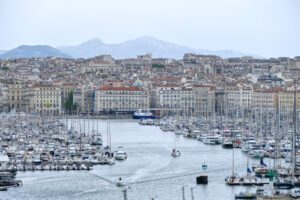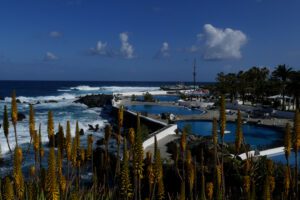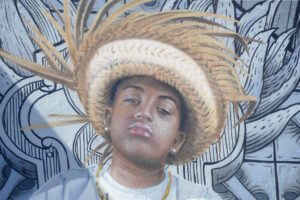The French Antilles island of Martinique is so beautiful that, strictly speaking, it needs no further embellishment: cool blue and turquoise tones of the Caribbean Sea, the endless white beaches, the lush green of the lush vegetation – who can match this splendor? Well, some brave street artists have taken up the challenge and competed with nature with their outstanding works. They created fantastic murals. This gives me the opportunity to introduce you to the best street art in Martinique.

Street Art in Martinique
Over the last few years, I have put together many posts about street art in many different countries: from painted walls all over Berlin to an abandoned hotel ruin on the island of Naxos. From socio-artistic ventures in Amsterdam, Copenhagen, and Paris to a glamorous and generously funded art project in Morocco’s capital Rabat.
The world seems to be covered with breathtaking murals by renowned artists.

Due to the abundance, street art has lost much of its subversive swag in many places. In London, the former cradle of punk, groups of tourists push their way through the gentrified and therefore tragically hip districts of Camden and Shoreditch.
On the other hand, districts such as the 13th arrondissement in Paris, the Copenhagen Nordvest neighborhood, or the satellite town of San Pablo in the northeast of Seville continue to be visually enhanced through murals in the first step and thereby made more livable in the long term.
But what about Martinique?
Same Past, Different Outcome
Not long ago I wrote a detailed post about urban art in Guadeloupe. I once again noticed how different the islands are despite their identical history. No, I’m not talking about Guadeloupe being significantly bigger than Martinique or any other kind of clearly visible differences. No, the big difference between the islands is more noticeable below the surface. It’s the mood, the vibe, the interaction.

People in Guadeloupe seem to be more direct and tough to deal with. A veil of anger seems to lie over the land. Even if the inhabitants of Martinique are certainly just as frustrated by the unresolved colonial history and the cruel legacy of slavery, this anger is more likely to be below the surface and only noticeable when you have very sensitive antennae.
This is primarily because after slavery was abolished in Guadeloupe, the colonial masters were removed: In June of 1794, nine ships carried more than 1,000 revolutionaries from France to Guadeloupe. One of them was the former merchant Victor Hugues. In his luggage was an unusual item that would never be allowed in your carry-on: Hugues brought a mobile guillotine to the island! It was set up in Pointe-à-Pitre’s Place de la Victoire where then, the colonial plantation owners and slave masters were beheaded.
In Martinique, however, the descendants of the former colonial masters are still the not-so-secret emperors of the isle. To this date, the wealth that they obtained during the colonial era grants them frightening power not only economically but also socio-politically.
Be Good
I can’t say for sure, but the difference in terms of content between street art in Guadeloupe and Martinique is immediately apparent. In Martinique, the motifs are friendly and obliging. Birds, sea turtles, plants, rural scenes – no Béké, as the descendants of white colonial rulers are called locally, can feel offended by this. These motifs don’t go where it might hurt.
Don’t we all enjoy harmony?
Aren’t all of us very much pro-protection of the environment?

Oops, already this at first glance rather a harmless topic might unpleasantly stir the pot. Shockingly, the Békés contaminated their banana plantations with chlordecone even decades after the poison had already been banned in other countries. As a result, their workers are now dealing with the highest rate of prostate cancer in the world. Hence, let’s not delve too far into the topic of environmental protection. It’s better to put a colorful fish on the wall, so unpleasant questions don’t come up.

The pretty, pain-free urban art in Martinique reminded me of the murals that are created every year during the Jidar Street Art Festival in Morocco: pretty, harmless, and above all, absolutely apolitical!
Since the murals in Martinique do not go where it hurts, it is also fitting that street art projects do not come from some grassroots artist collectives, but are organized very professionally by the squeaky-clean Canada-based agency Milmurs Productions.
The Artists
Most of the works presented in this post can be found in Fort-de-France. Nevertheless, I also introduce some pieces that can be found in other areas of the island. Therefore, I have once again decided to present the artists in alphabetical order. On the map at the end of this post, you will find the exact location of their works that I’m listing in this post.

I’d like to point out the high number of female muralists. While in my article about urban art in Guadeloupe, only two of 17 artists were female, in the list below, six out of 18 are women. That’s a third and the highest proportion I’ve recorded in all of my street art posts.
Way to go, Martinique!
3TTMan
Louis Lambert aka 3TTMAN was born in the French city of Lille. His artist name 3TTMAN stands for Homme à Trois Têtes, which translates to three-headed man. In 1999, he began beautifying the streets of Lille with his art.
Lambert is a versatile artist who tries out and integrates various forms of popular art in his work. Whether in his daily life or on numerous travels, 3TTMAN brings current topics into symbolic forms.

He uses an assortment of materials from cement to ceramics to papier-mâché. The formats of his works range from small paintings to gigantic murals. In his street art, he also uses large-format mobile painting surfaces, which are then attached to walls.
As an artist, Lambert stands at the crossroads of contemporary art, crafts, and street art, obviously. He proves that all forms of expression can become art and that there is no right or wrong.
For 3TTMAN, the journey is the goal and the creative process is a vital part of the result. The great joy in his work can be felt in every one of his brush strokes.
3TTMAN has lived in Spain since 2001 where he became an important representative of Madrid’s contemporary urban art scene.
Bilel Allem
The French artist Bilel Allem initially developed as a self-taught artist between the graffiti of the hip-hop scene and Japanese manga. He later graduated from the École des Métiers du Cinéma d’Animation in Angoulême.

Despite his professional training, Allem remained true to a free, cubist, and surrealist way of working. Although he developed ambitious creations for animated film productions and even music videos like the one for Snoop Dogg feat Blakkamoore, he kept his passion for murals.
In addition to his participation in various artistic projects, he continues his career as an illustrator and director for artists, media, companies, and organizations. Allem works either as a solo artist or together with the crew Les Enfants Sauvages, which he founded.
Allem keeps his art hybrid by putting analog pictures into digital contexts. The artist combines graffiti in public spaces with animation and uses so-called augmented reality to create the illusion of graffiti in motion.
Ana María Ortiz aka Ana Marietta
Ana Marietta was born in Puerto Rico. There she graduated from the University of Puerto Rico in 2005. Eventually, she moved to Houston where she found herself in a totally new and at times intimidating surrounding full of opportunities and challenges. However, she is grateful for the chance that her artistic activity has taken her to places she never dreamed of visiting.

The artist believes that everyone should have access to art. Therefore, presenting her art in public spaces gives her great satisfaction.
Because of her scientific background, she often places imaginary animals and humanoid creatures at the center of her work. She creates imaginary animals that can fly underwater or swim through the air.
Ana Marietta enjoys inspiring people of all ages and uniting communities through art.
Ronald Cyrille aka B.Bird
Ronald Cyrille aka B.Bird is one of the most prominent members of the artistic community in the Caribbean. Born in Guadeloupe in 1984, he spent his childhood between Guadeloupe and the neighboring island of Dominica. Since B.Bird experienced life as a Frenchman in Dominica and then as a Dominican in Guadeloupe, he gained an open and comprehensive view of the Caribbean. Through his work, he returns to the different places of his eventful childhood. He immortalizes his homeland’s mythology and folklore in his paintings, which makes him a veritable visual storyteller.
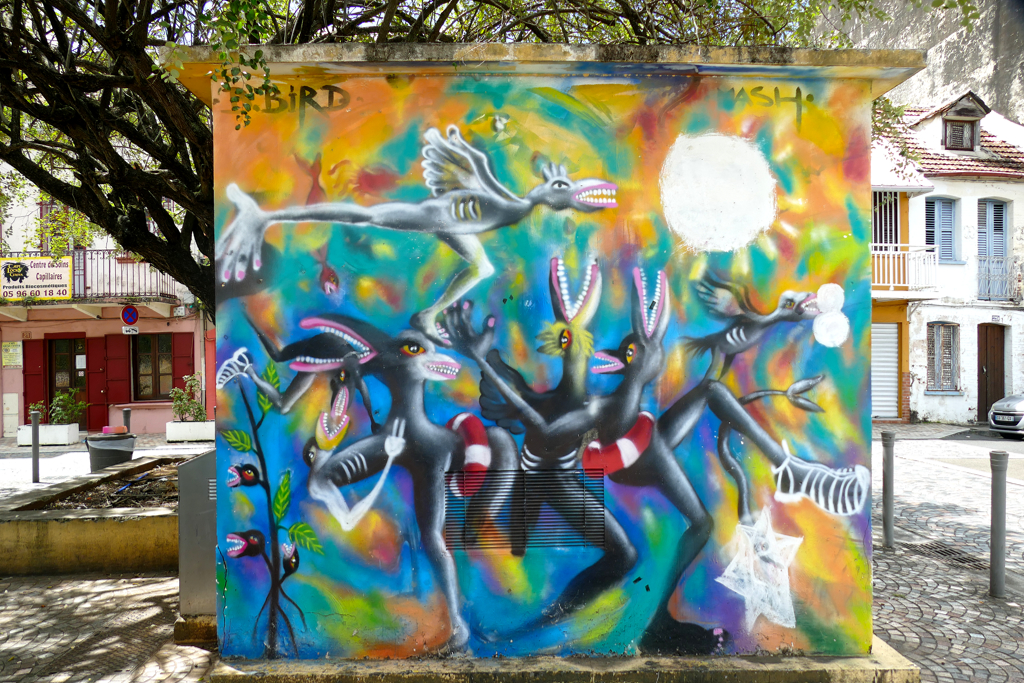
Although today, B.Bird enjoys international recognition with his mythical creatures and mystical scenes, his greatest claim to fame so far was an engagement as an artist in residence at the glorious Memorial ACTe, the museum of the history of slavery in Guadeloupe’s main city Pointe-à-Pitre.
Danaé Brissonnet
Danaé Brissonnet is a French-Canadian artist from Quebec. Apart from street art, she dedicates herself to mask-making, puppetry, and also illustrating.
To her, working as an artist is far more than just creating something pretty. She invites her audience into a world full of symbolism, myths, and metaphors. Also, she needs to immerse in the culture’n’community of the places where she leaves her mystical traces on façades and walls for instance by organizing workshops.

You can find Brissonnet’s elaborate fantastical and very colorful murals in many European cities, but also in northern and western Africa, the US, Canada, Mexico, and India. I saw her work for the first time during my stay in Morocco’s capital Rabat, and I was immediately intrigued by the imaginative figures that she depicts with impressive attention to detail.
I’ve introduced Danaé Brissonnet in my post JIDAR Street Art Festival – How Rabat Celebrates International Urban Art, and also in my post on urban art in Guadeloupe where she painted a fabulously surrealistic mural in Port Louis.
Brothers of Light
In 2015, siblings Elna and Gab founded the multidisciplinary artist duo Brothers of Light. They were guided by their mother’s desire they ought to join forces and do good. So after her death, they began to work together under this optimistic and promising name.

In their work, the brothers bring together ancient cultures and symbols with their childhood memories, but they are also inspired by their recollections from travels around the world.
They work on canvas, wood, and metal as well as on the walls of many cities, obviously, applying a wide variety of media and techniques.
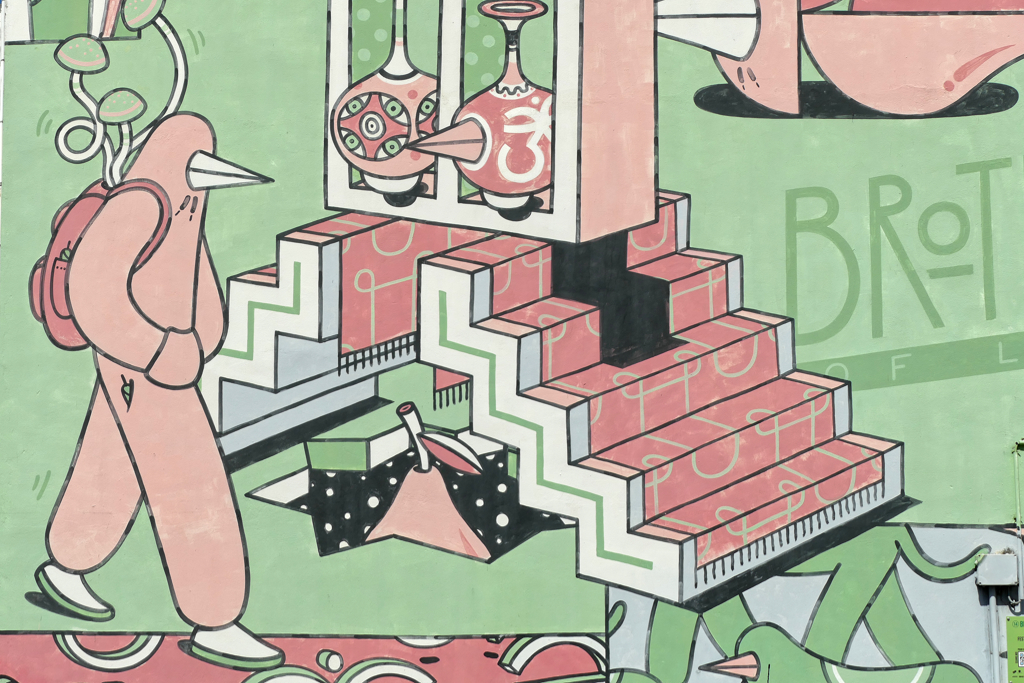
Over the years of the shared creative process, they developed a mutual visual language that consists of naive motifs and dreamy figures in light colors. Hence, Brothers of Light: Because
at the end of the day, their goal is to spread light and positivity through their work and have a positive impact on the world.
They have participated in numerous international street art festivals in Germany, France, Mexico, Portugal, the USA, and their home Israel. There, they presented their project From Dirt in 2022, for which they spent three years painting over a hundred metal pieces that they recovered from a landfill near their studio.
Co2Cythere
Except for the fact that Co2Cythere’s real name is Corentin de Sieter, I was unable to find any other relevant information about him despite my detective’s diligence.

I’ll stay tuned and would be very grateful for any information.
DOUDOU STYLE
Doudou is an artist with many skills and an inexhaustible level of energy. Therefore, she creates an exceptional variety of works: portraits, interior designs, trompe-l’œil, and graffiti. She keeps surprising her fans with works in very different styles: hyperrealistic, comic-like, or surrealistic. With Doudou, who is one of the very few women active in the street art scene, you never know what to expect.

In addition to many different art styles, Doudou also uses all kinds of surfaces for her works, such as canvases, clothing, and walls, obviously. She has also joined many artistic collaborations, for example with Vagabombe Wear, the Moulin Crew, and the Photograffée collective. She also loves inspiring others and passing on her skills in courses and workshops.
Florianne Moustin
Florianne Moustin was born in the town of Schoelcher in 1998. She is a full-time, self-taught artist.

She expresses her love for her home island in magnificent, colorful paintings. Whether the portrait of the Martinican Goddess, which she created on a façade in the Dillon district of Fort de France, or her pictorial homage to Cyparis, the most famous of the three survivors of the volcanic eruption of 1902: Martinique, its people, but also its breathtaking natural beauty stands in the center of Florianne’s work. By the way, I highly recommend that you read Cyparis’ incredible story in my post MAGNIFICENT MARTINIQUE: Ten Places Not to Miss on Your Visit (even when exploring by public bus).
Florianne, who can rightly be called a folk artist, embellished also the façade of the town hall of Morne-Vert with the depiction of a spring hidden in Martinique’s mountains. This source had already inspired the poet and writer Aimé Césaire, which brings us back to the artist’s close connection with the tradition and culture of Martinique.
MURMURE STREET
Paul Ressencourt and Simon Roche are both graduates of art schools. The French street artist duo with the clever name Murmure Street have been creating urban art together since 2010.
Their focus is on dreamlike, playful, and poetic motifs that fit into the respective environment and interact with it. Although there is a deeper message behind each of their works, Murmure Street leave everyone free to interpret each work as they wish.

The techniques used make Murmure Street strong Depending on the type of project. Due to their in-depth training in the art field, they have mastered all types of techniques such as freehand painting, drawing, stenciling and collage. They then achieve a hyper-realistic appearance by combining them with acrylic, spray paint and black chalk. This is how Murmure Street brings their surrealist motifs into a hyperrealistic context.
Murmure Street’s art has been featured in several publications and they have been involved in exhibitions in Paris and London.
William Njo aka NJO 972
William Njo is of Martinican origin and was born in Noisy-le-Grand, a commune in the eastern suburbs of Paris, in 1987.
After living in Guadeloupe and Martinique for 18 years, he returned to France at the age of 19.
Although he had no formal training as an artist, he received a lot of advice and was able to develop his individual style. His favorite motifs are women and children. However, so far art has only been his side hustle.
He used his visit to his family in Martinique to beautify the island with his iconic collages.
You can see one of his portraits next to Raf Urban’s piece below.
Ochéa
Two young Martinican street artists, namely Ochéa and Xän, have honored Khokho René-Corail with a mural on a wall in the town of Les Trois Îlets. They rightly consider Khokho to be a pioneer of urban art on the island. In their work, they pay respect to the artist by surrounding him with some of his favorite motifs and characters.

Khokho René-Corail, who sadly died in 1998, was a brilliant artist. One of his works can be seen in Les Trois Îlets just around the corner from Ochéa and Xän’s portrait.
Now when it comes to Ochéa, I unfortunately have to admit that despite my detective’s diligence, I was unable to find any other relevant information about him. I’ll stay tuned and would be very grateful for any information.
Raf Urban
Raf Urban was born in 1971 and grew up in a suburb of Paris. This is also where the self-taught artist’s creative path began.

His great passion is the stencil technique, which contains an artistic combination of militancy and poetry. The main motifs of his work are women such as the civil rights activist Angela Davis, the Pakistani women’s rights activist Malala Yousufzai, but also celebrities like Amy Winehouse.
Raf Urban left his works on the walls of many cities, but especially in the Paris area.
Roxanne Shade
After graduating from high school, Roxanne Shade studied art at the Caribbean Arts Campus in Martinique.
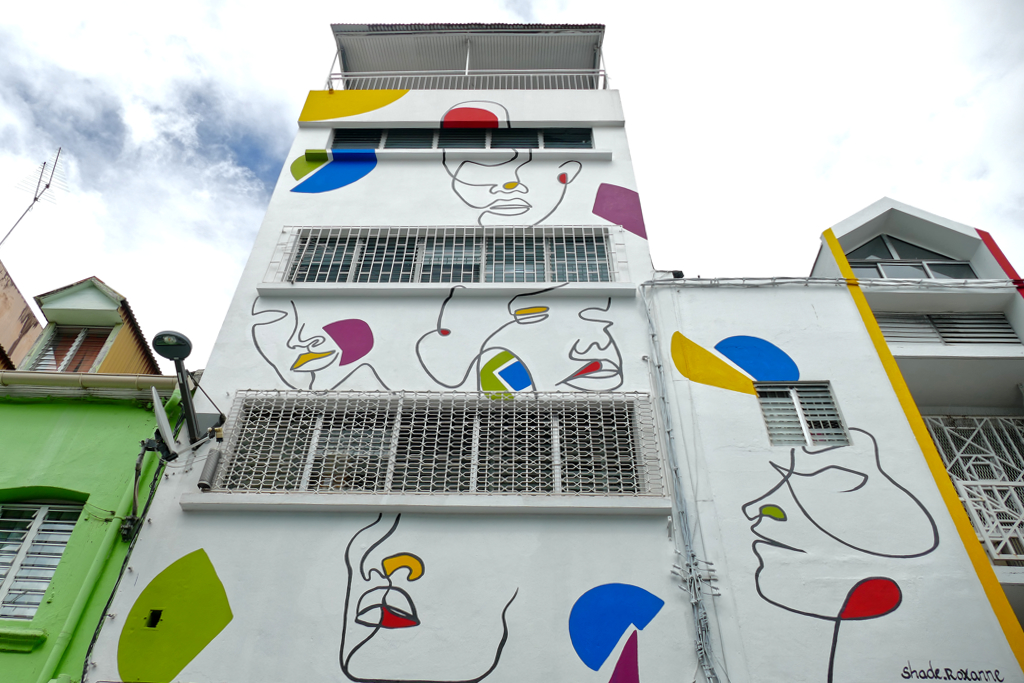
In her graphic works, she explores physicality and plays with the interaction of fullness and emptiness. Most importantly, the artist attaches great significance to precision and details.
What inspires Roxanne is not so much emotions as such, but rather their consequence and their impact on us. She also invites the viewer to embark on an introspective journey and discover the nuances and hidden meanings behind her creations.

Roxanne continues to constantly develop her artistic approach. She strives to continually explore and experiment with new shapes and forms.
Veks Van Hillik
Veks Van Hillik was born in a small village in the southwest of France in 1988. Today, he is based in Toulouse.

He was passionate about painting and drawing from a young age. His first source of inspiration was the nature that surrounded him. Eventually, he found stimulation in the works of painters as diverse as Jean-Auguste-Dominique Ingres, Caravaggio, and Salvador Dalí as well as the surrealist writer and poet André Breton. Also heavily influenced by pop culture such as comic strips, street art, and tattoos, Veks Van Hilik ultimately developed his personal style. In his at times a bit sinister works, he portrays the hidden core of situations and characters directly from his imagination.
His work has been presented at numerous exhibitions in Australia, Italy, the USA, and France, obviously.
VINIE
Vinie was born in Toulouse. She painted and drew as a child and then began to create graffiti during her high school years. In 2001, she met the AH crew. At that time, she only created tags.
Art festivals and creative murals encouraged her to depict characters and paint entire scenarios.

In 2007, she came to Paris to work as a creative director. At that time, she developed her art in a more personal, figurative direction. She painted female figures on the walls of the French capital which can always be recognized by their unruly hairstyles and other recurring details. As soon as you see them, you know you’re looking at a Vinie.
Vinie strives to incorporate the surroundings into her works as much as possible, in particular vegetation.
She has participated in many international urban art festivals. In doing so, she combines her two passions, namely painting and traveling.
WAONE Interesni Kazki
In 2005, Volodymyr Manzhos aka WAONE founded, together with Aleksei Bordusov aka AEC, the Interesni Kazki project. Interesni Kazki translates to Interesting Fairy Tales. Obviously, this explains why the Ukrainian crew is best known for their large-scale surrealistic and colorful murals depicting fantastic sceneries. Their fairy tales are allegorical and figurative and use images that leave room for personal interpretation.
After experimenting with different techniques, they finally settled on using traditional brushes, paint rollers, and acrylic paint.

WAONE’s father was an avid collector of contemporary art as well as rare Orthodox icons. Therefore, young Volodymyr grew up in a house full of works of paintings, old icons, and art books. He started drawing at the age of five. In 1999 he gave himself the nom de plume paintbrush WAONE. Before he joined forces with AEC in 2003, he had already tagged with the Ingenious Kids crew in Kyiv.
To date, WAONE has decorated many cities such as Mexico City, New York, Paris, and Kyiv with his murals.
In 2014, he created a mural in Kyiv condemning Russia’s invasion of Ukraine. Since 2022, after the war began, he has painted several murals in Ukraine but also in Poland, the USA, and France to support the Ukrainian cause.
John Wentz
John Wentz was born and raised in the San Francisco Bay Area. His interest in art began at the age of six when he discovered comics of superheroes. After years of practicing copying comics, he was able to make a living as a commercial muralist, poster designer, and illustrator. Eventually, he decided to devote himself to fine art and work with oil paints.

Wentz’s art is a work of constant development of processes and techniques. His goal is to reduce the picture to its core elements. The composition and application of paint are simplified and rather rough. This makes his art appear unfinished and abstract.

John Wentz has participated in numerous group exhibitions in the USA and many other countries. In San Francisco, he had five solo exhibitions. Wentz has received several awards and his works have appeared in numerous art publications.
Xän aka Nuxuno
Stéphane has given himself many names: Nuxuno, Xanoy, or Xän, obviously. Regardless of the name, he is one of the most famous street artists in Martinique. With a portrait of Spike Lee from 2013, he created one of the most photographed works on the island.

Many of Xän’s works celebrate Creole culture in the form of flowers, traditional hairstyles, and the typical madras check. These features are not purely folkloric features, but above all a homage to the local identity and Creole heritage.

Although Fort-de-France and lately also the town of Schœlcher, named after a famous abolitionist, have the highest number of murals, artists are increasingly migrating to other places on the island. Saint Pierre on the central west coast and Sainte Anne in the south are particularly artsy. There, in an imperceptible backstreet, Xän left some large-format portraits. So if you follow my guide to The Best Beaches in Martinique You Can Easily Visit by Public Bus, you should definitely foresee time for a little cultural tour of Sainte Anne.
Xän also worked on the portrait of the artist Khokho René-Corail, which I presented above in the part about Ochéa.
On Instagram
To dig deeper into the subject and see more of the amazing art the above-featured artists have created, you can just check out their Instagram accounts:
3TTMan
Bilel Allem
Ana María Ortiz aka Ana Marietta
Ronald Cyrille aka B.Bird
Danaé Brissonnet
Brothers of Light
Co2Cythere
DOUDOU STYLE
Florianne Moustin
MURMURE STREET
William Njo aka NJO 972
Raf Urban
Roxanne Shade
Veks Van Hillik
VINIE
WAONE Interesni Kazki
John Wentz
Xän aka Nuxuno

How to Get Around
When planning my trip to Martinique, I heard that public transport is neither comprehensive nor reliable. I would definitely need a car to be able to enjoy the island to its full extent. Well, I don’t know exactly what the full extent is supposed to be. However, after almost two weeks in Martinique, I can say that I got everywhere I wanted to go by local bus.
The bus network is well developed, I can’t think of any place that doesn’t have a bus service. Some places are also served by several lines. The network is divided into south, central and north, a journey between towns costs around 2 euros, journeys with local buses cost 1.50 euros. You can purchase a season ticket or buy tickets using the App MT Ticket. It was too much effort for me for almost two weeks on the island, so I bought my ticket from the driver every time.

Yes, there are plenty of buses that go to the most remote corners of the island. However, you often have to change buses at least once; for longer distances, this can sometimes take three or four legs.
But Renata, that’s not so bad.
Better Late Than Never Early
Well, hold that thought. I’m afraid you’ll change your optimistic attitude when I tell you that the waiting time for the next bus is often half an hour, but sometimes also 45 minutes. And that’s according to the schedule. In addition, your first bus may have been particularly fast so that you arrive at the connecting stop ten minutes before the scheduled time, but the next one is fifteen minutes late. Now calculate the waiting span in real time and the whole thing doesn’t sound so great anymore.
Obviously, these are extremes. If this kind of connection was always the case, I certainly wouldn’t be promoting enthusiastically taking the bus. However, a very long wait can occur. One consolation: the most important junctions where I had to wait for long were always at a roundabout where there was at least one major supermarket. So I simply used the waiting time to do my shopping – either refreshments for the beach or groceries for my apartment. That was very beneficial, I just had to keep an eye on the time and remember that the next bus could come ten minutes earlier than scheduled, so I had to make it back to the stop in time.
Prepare
With very few exceptions, I think it is essential to check your connection options for the day and, if possible, write them down so that you don’t get confused. You can easily check routes on Google Maps. Simply enter the start and destination and the desired departure or arrival time. Then click on the little bus symbol and you will see all the options. Things get a little better with the App Martinique Mobilité. It works the same as Google Maps, but you can easily save the connections and don’t have to write them down or remember them.
Extra Tip
A ferry runs about every hour across the bay between Fort-de-France and some spots on the opposite peninsula. Not only is it idyllic, but it is also often quicker if you come from the south. The round trip costs 7 euros, so it’s a little more expensive than the bus, but it’s definitely worth the money.
Ten Crucial Tips For Exploring Martinique By Public Bus
- The most important tip to make your bus ride at least tolerable: Do consider the passage a valid part of the whole experience.
If you consider your bus ride a wasted period of time between two meaningful activities, you’ll get mad. Think of it as an original tour in an authentic vehicle: Look out the window and enjoy the amazing scenery, the turquoise waters, the endless sugarcane fields, and the swaying palm trees. Try to get a good glimpse of the towns and villages.
This is neither New York nor Paris nor Tokyo, this is a Caribbean island, and the bus ride is part of the whole experience. So do yourself a favor, reset your watch, lean back, and go where and when the bus takes you.
————————————— - Don’t plan too much for one day. One or two destinations will be enough. Taking a day trip on public buses in Martinique is much more complicated and tiring. You’ll be walking quite a bit, you’ll have to carry all sorts of stuff with you, you’ll have to plan for longer waiting times, and all this in the tropical heat. Believe me, I’m a trooper when it comes to itineraries. That’s why I planned five spots on my first day. I would have even completed the program. But in the afternoon, I was completely exhausted, so I postponed the last stop to another day. From then on, I limited my itineraries to two spots. This way, I was often back around 3 p.m. and had still two or three hours left to relax on the beach with a nice book.
————————————— - However, plan your trip as thoroughly as possible in advance by using Google Maps or the App Martinique Mobilité. Yet, since the buses are not a hundred percent reliable, stay flexible, don’t freak out, and consider an alternative connection as you go.
————————————— - Be at the stop at least ten, better 15 minutes before the scheduled time.
————————————— - While waiting, don’t get distracted by reading or chatting with others. Keep your eyes on the road if the bus is coming. Because if you just hang around at the bus stop, the driver won’t consider you a potential passenger and might just merrily pass you by. As soon as you see the bus approaching, give the driver a sign by lifting your arm or waving.
————————————— - Keep in mind that the vehicle might look different from what you expect it to be. Instead of a large coach, it can be just a middle-sized white van with the number on a piece of paper in its windshield. This info is relevant as you have to flag the bus down. It happened to me that, for some reason, I expected a certain bus to be big and colorful. Only as a white van raced past me did I realize that I just missed my bus.
Therefore, it’s better to wave frantically to a potential vehicle once too much than let it pass you by.
————————————— - Make sure to have small change to pay your fare as the drivers accept only bills up to 10 €uros.
————————————— - Try to take the bus at the final stops respectively as early as possible: If you have the choice between two stops, wait at the one the bus serves first. Mind you, once all the seats are taken, the bus is full and the driver will leave you standing at the bus stop. Especially in areas where there are only a couple of those smaller vans a few times a day as well as during rush hour in the afternoon, it is the survival of the fittest.
————————————— - Never rely on the last possible connection or the latest scheduled coach. Plan your trip in a way that you can take at least one later bus.
————————————— - Even if you are totally opposed to hitchhiking, consider hitching a ride your last resort. Never have I ever hitchhiked before, yet, Martinique’s bus drivers made me leave that comfort zone right on my very first day on the island.
Map
This map should help you find the murals I’m introducing in this post. Clicking on the slider symbol at the top left or the full-screen icon at the top right will display the whole map, including the legend.
Looking for the Best Street Art in Martinique was only one of the awesome things I got to do on my visit to the island. For stories and information on other parts of the island, check out my posts
MAGNIFICENT MARTINIQUE: Ten Places Not to Miss on Your Visit (even when exploring by public bus)
The Best Beaches in Martinique You Can Easily Visit by Public Bus
Pinnable Pictures
If you choose to pin this post for later, please use one of these pictures:


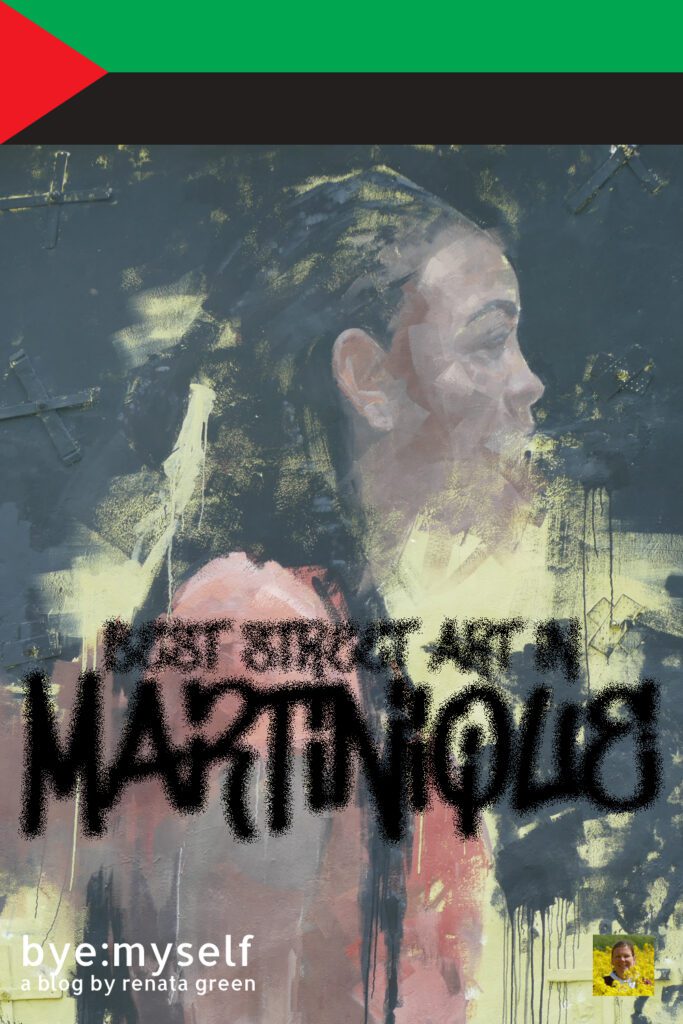


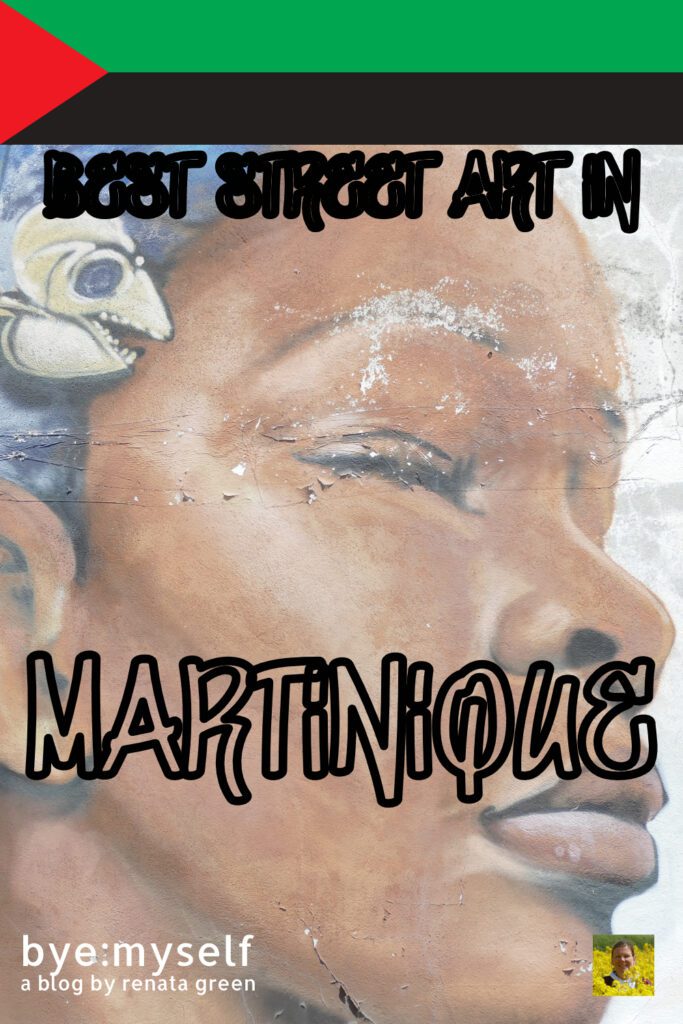
Note: I’m completing, editing, and updating this post regularly – last in August 2025.
Did You Enjoy This Post? Then You Might Also Like These:
Two Days in MARSEILLE – What Not to Miss in the Belly of France
Guide to PUERTO DE LA CRUZ – a Town Full of Contrasts
CURACAO – Guide to the Caribbean Island That Has It All
IF WALLS COULD SPEAK: The Best Street Art Project in Amsterdam
MAGNIFICENT MARTINIQUE: Ten Places Not to Miss on Your Visit (even when exploring by public bus)
One Day in NÎMES – What Not to Miss in the Most Roman City of France
Four Days in AMSTERDAM – Unique Things To See on a Long Weekend
ARUBA: The Powerful Murals of San Nicolas
* This is an affiliate link. If you book through this page, not only do you get the best deal. I also get a small commission that helps me run this blog. Thank you so much for supporting me!
